In this installment of her Eat Ireland column, Deputy Editor Jocelyn Doyle heads to Kilkenny for a taste of Irish history.
The image of a monk is perhaps not the first to spring to mind when you think of getting piddly, but the story of poitín begins in a monastery. Christian missionaries travelling the Mediterranean region brought the knowledge of distillation back to Ireland in the early sixth century, and poitín was first produced in monasteries around 584AD. It wouldn’t be long before the skills (and demand!) began seeping out to the general population. This being a thousand years before the potato reached our shores, poitín was originally made using barley. Once the starchy spud came along, however, it was commonly used.
With such a long history, it’s little wonder that there’s no drink more tied to Irish culture than poitín (with the exception, possibly, of whiskey), and Morgan Ging is a poitín distiller uniquely tied to the Irish landscape. Not only has he been a farmer all his life, but his father’s side of the family has an unbroken farming lineage as far back as written records go. “On my mother’s side,” he tells me, “there is a mixture of farming and business; her father had a grocery shop and bar on their family farm, with a licence to blend whiskey.” The intertwined histories of farming and whiskey held a fascination for Morgan growing up, and for 25 years he harboured the ambition of one day reviving the lost tradition of having a family farm distillery.
Morgan learned the craft of distilling from Jamie Baggott, a much-lauded Master Distiller. “My own qualifications and experience in mechanical engineering were the perfect background to master the equipment and production, which is a steam-based operation.” He spent five years studying before working for one year as Jamie’s apprentice.
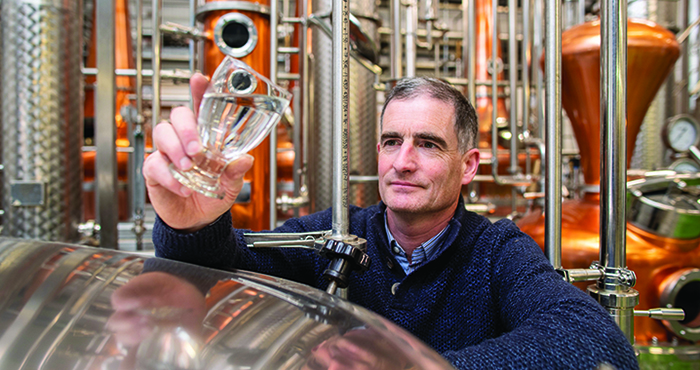
Morgan Ging, Ballykeefe Distillery
Morgan’s family farm at Ballykeefe, Co. Kilkenny, is the fruits of these long labours. The Gings farm 160 acres where a symbiotic relationship between their cattle, barley and whiskey is at the very heart of the operation. Morgan describes the farm as “a single estate distillery, from our fields to your glass.” The barley they grow is used to make their poitín and whiskey, and they feed the by-products of brewing and distilling to the cattle. “They love the spent grains and pot ale.” These cattle go on to become Ballykeefe Beef, with a subtle whiskey flavour and tender texture. With a limited supply, the beef is available only in Kilkenny restaurants.
A commitment to sustainability runs through everything at Ballykeefe, and is prioritised in every aspect of the farming and distilling operations. The farm is a flagship member of Bord Bia’s Origin Green programme, and has invested heavily in ensuring the lowest possible carbon footprint and zero off-farm waste. Ballykeefe’s customers are people who care deeply about traceability and sustainability, and consciously choose spirits that are authentically artisan and premium quality. “The importance of traceability is something we learned from farming.” Morgan says. “People want to know the story behind the product. That’s why our motto is, “If it says Ballykeefe on the label, then it’s Ballykeefe distilled spirits in the bottle.”
A typical day begins at 6.30am, starting the brewing process in the distillery and then heading out to perform the many tasks that keep a farm running. “Now that the distillery is operational,” says Morgan, “I balance my time between farm work and the distillery; overall, they’re much longer days than before. My day finishes at 9.30pm when the cattle in the slatted unit receive their last meal of the day.”
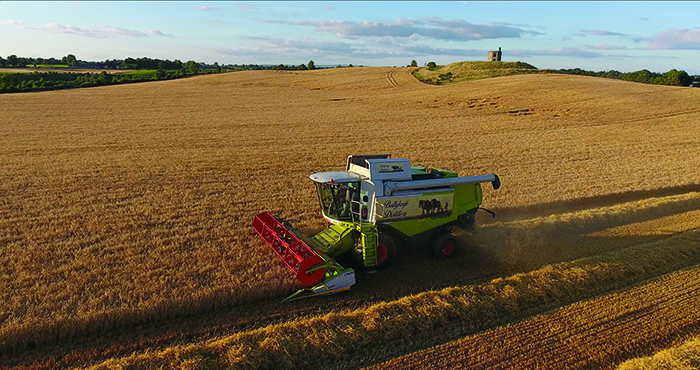
Ballykeefe Farm
The distillery produces artisan vodkas and gins as well as the poitín, with the first batch of Ballykeefe Whiskey currently maturing in casks. While the gins are thus far the star sellers, having just won gold at the 2019 World Gin Awards, the other spirits are doing very nicely, too: in 2018 alone, the vodka was awarded Best Irish Vodka at the Irish Whiskey Awards and the poitín won Master Class at the 2018 Global Spirits Masters.
With honours like this up for grabs, it’s strange to think that poitín was illegal for much of the last five hundred years. When the British government introduced new taxation on alcohol in 1661, little did they know how crafty we Irish could be in protecting our much-loved moonshine. Distilling became clandestine; stores were concealed in secret cellars; speakeasies were widespread. When the authorities tried to tax the size of the pot still — guaranteeing their levy, no matter the quantity produced (or hidden) — we simply started using the smallest stills we could. Even the word poitín means ‘little pot.’ Let’s be honest: the secrecy of the affair only made it more craic.
Poitín is also entwined in the story of the wake, in possibly the most Irish of all traditions. The phrase ‘dead drunk’ came about because over-indulgence in poitín could bring on a catatonic state with all the hallmarks of death. The tradition of ‘waking’ the dead is actually designed to give poitín’s effects a chance to wear off and to prevent those pesky accidental live burials; it’s literally called a wake because the person in question may just wake up.
Since 2008, the cultural significance of poitín has been recognised with a legally protected geographical status, meaning that it can only be made in Ireland (just like anything labelled Champagne must come from the Champagne region in France). “The poitín of today is very different from its illegal predecessor,” Morgan says, “and is crafted to exactly the same standards as whiskey.” In fact, the only real difference between the two is that the poitín doesn’t spend time aging in oak casks — just like the whiskey, it is made from a combination of malted and unmalted barley and goes through a seven-day, seven-stage milling, brewing, fermentation and distillation process.
It wasn’t until 1997 that poitín was made legal again, and you’d be hard-pushed to find an Irish person of 30 or older who doesn’t have a fond — or not so fond — memory of a sneaky cleaned-out and refilled plastic bottle that could put hair on your chest. Gone are the days of home distilling, or at least officially gone: I believe there’s many a hearth down West beside which you might yet be offered a drop.
While modern, legal poitín might not sit as well with our romantic rebel hearts, it does carry the advantage of being guaranteed safe to drink — and, as more and more distilleries begin to make their own, there’s an interesting range of flavour profiles appearing. Poitín has gone a little bit fancy. Yes, it’s far from flavour profiles we were reared, but that doesn’t stop food and drinks nerds like myself being intrigued.
Experts have described Ballykeefe Poitín as, “warming and viscous, with a malted biscuit flavour and hints of red pepper and new oak.” While it can still be enjoyed straight up like the old days, Morgan’s favourite way to enjoy it is with ginger ale and a slice of orange, and he says that mixologists find it perfect for use in cocktails. I put this to the test with our apple sour recipe — the ideal way to raise a glass to Irish history and our rich, rebellious culture. Say what you like about those monks, but they knew how to drink.
- summer events
- small business
- gut health
- OATLY
- healthy
- Crudo
- top tips
- All Together Now
- fridge cake
- Events Waterford
- food festival
- Events Ireland
- me auld flower
- news
- dublin
- events Dublin
- dublin festival
- Home-Cooking
- food and drink festival
- online cooking course
- festival line-up
- cooking
- Summer festival
- eco-friendly
- Events
- cosy
- Festivals Ireland
- wine
- Body & Soul
- grapes
- music festival
- south africa
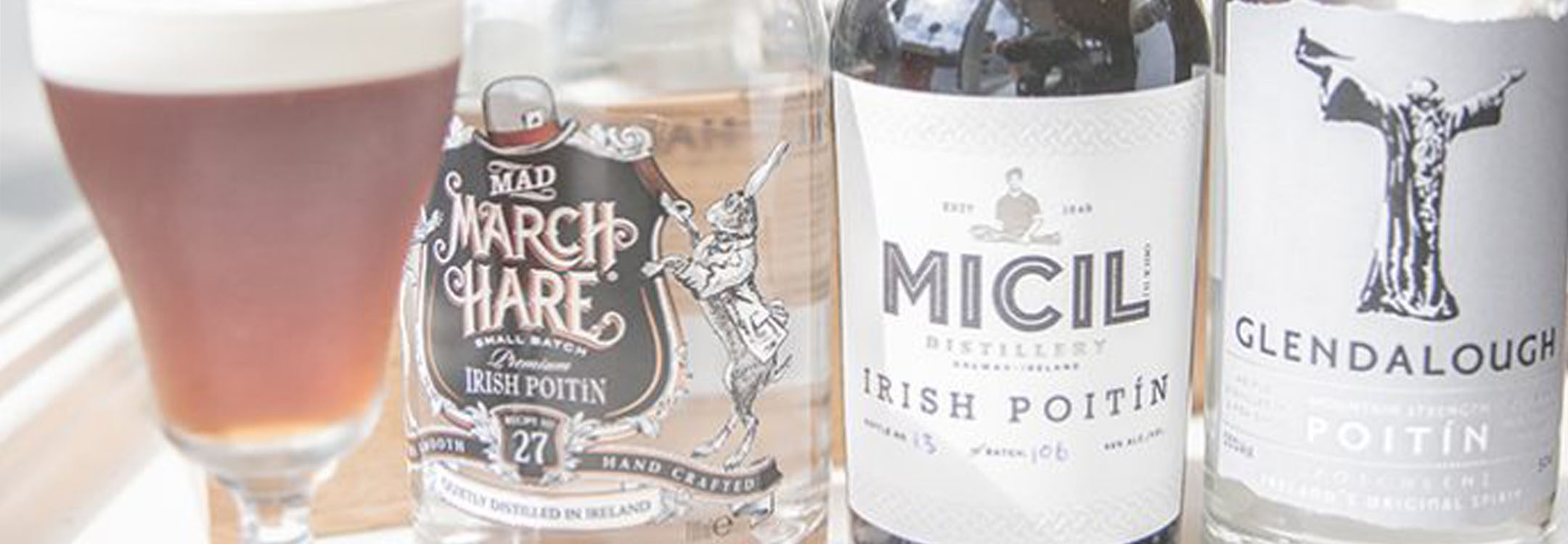

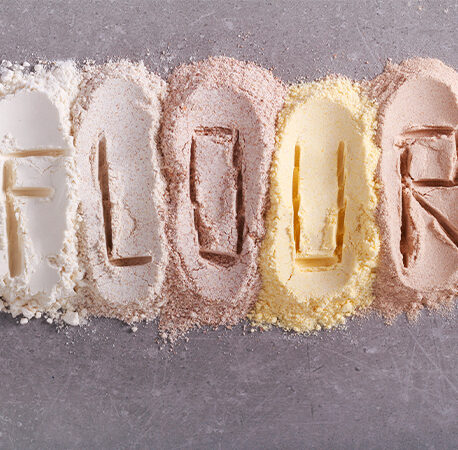


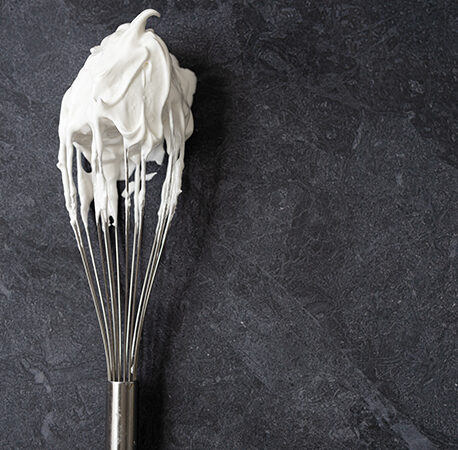
You have to be signed in to comment this post.